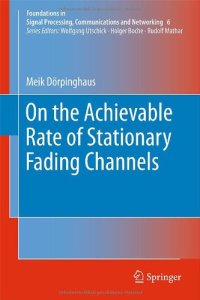
Ebook: On the Achievable Rate of Stationary Fading Channels
Author: Meik Dörpinghaus (auth.)
- Tags: Communications Engineering Networks, Coding and Information Theory, Computational Science and Engineering, Signal Image and Speech Processing
- Series: Foundations in Signal Processing Communications and Networking 6
- Year: 2011
- Publisher: Springer-Verlag Berlin Heidelberg
- Edition: 1
- Language: English
- pdf
Virtually all mobile communications systems face the problem that transmission takes place over a time-varying fading channel whose realization is unknown to the receiver. For the design of communication systems it is important to know performance limits for communication over such channels. Therefore, the present book discusses various aspects regarding the capacity/achievable data rate of stationary fading channels. In this regard, it spans a wide range from bounds on the capacity/achievable rate for such channels to a study of the achievable rate with practical receivers. It reveals in detail which portion of the mutual information between the transmitter and the receiver can be retrieved in practice by synchronized detection.
In this context, the book covers:
- A study of the achievable rate of stationary Rayleigh fading channels, mainly focusing on i.i.d. Gaussian input symbols, including multiple-input multiple-output and frequency-selective channels.
- An examination of the achievable rate with practical systems relying on pilot symbols, including conventional receivers using synchronized detection with a solely pilot based channel estimation, enhanced receivers using code-aided channel estimation, and a comparison to the achievable rate with optimal joint processing of pilot and data symbols.
- An investigation of optimal discrete input distributions, showing that periodic pilot symbols as used in practice are not capacity-achieving in general. However, they allow for receiver implementations with reasonable complexity while showing only a small decrease in performance.
This volumes discusses various aspects regarding the capacity/achievable data rate of stationary Rayleigh fading channels. First, it analyses bounds on the achievable data rate with zero-mean proper Gaussian input symbols, which are capacity achieving in the coherent case, i.e., in case of perfect channel knowledge at the receiver. These bounds are tight in the sense that the difference between the upper and the lower bound is bounded for all SNRs. The lower bound converges to the coherent capacity for asymptotically small channel dynamics. Furthermore, these bounds are extended to the case of multiple-input multiple-output (MIMO) channels and to the case of frequency selective channels. In a further part, the present work studies the achievable rate with receivers based on synchronized detection and a code-aided channel estimation. For a specific type of such a receiver an approximate upper bound on the achievable rate is derived. The comparison of this approximate upper bound and the achievable data rate with receivers using synchronized detection based on a solely pilot based channel estimation gives an approximate upper bound on the possible gain by using this kind of code-aided channel estimation in comparison to the conventional receiver using a solely pilot based channel estimation. In addition, the achievable data rate with an optimal joint processing of pilot and data symbols is studied and a lower bound on the achievable rate for this case is derived. In this context, it is also shown which part of the mutual information of the transmitter and the receiver is discarded when using the conventional receiver with synchronized detection based on a solely pilot based channel estimation.